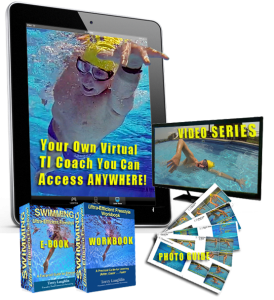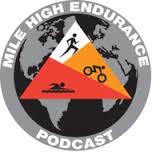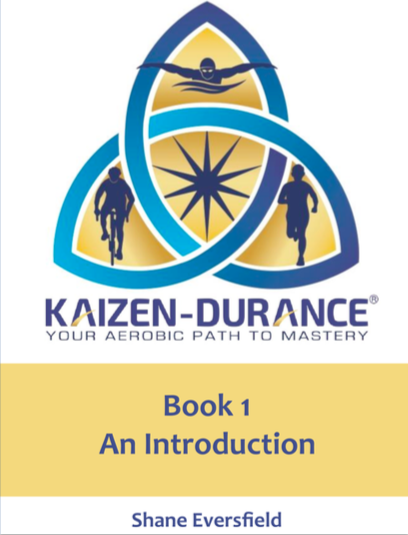Terry Laughlin's Blog, page 12
June 14, 2017
What Convinced Me to Breathe Bilaterally after 28 Years?
In August 1972, in the first 10 minutes of the first workout I ever coached, I noticed that every swimmer on the team I’d just begun coaching had asymmetrical strokes. To varying degrees, everyone who breathed to the left twisted noticeably in that direction; right breathers did the same to the other side.
While I had no formal knowledge of stroke mechanics at the time, instinct told me that these excessive sideways motions probably hurt efficiency. When I instructed the team to breathe to the ‘wrong’ side the next day, their lack of symmetry disappeared. Before long I made it a standard requirement for the swimmers I coached to breathe bilaterally during practice.
A primary reason breathing in freestyle is such a frequent occasion for stroke errors is the difficulty of keeping the body aligned, stable and traveling forward when 8 percent of body mass repeatedly moves to the side. When we move that 8% only to one side, it’s inevitable that, over time, the body reacts to these uneven forces in various ways—most of which hurt efficiency.
Though I required my swimmers to breathe bilaterally as early as the 1970s, when I got serious about improving my own efficiency in the early 1990s, I was still a one-sided breather. I always breathed to the left, just as I’d done since I got serious about swimming by pursuing the Red Cross 50-Mile Swim badge in the summer of 1964.
Twenty-eight years later, on a day in March 1992, I decided to breathe to the right while swimming with a local Masters group in Los Banos del Mar, a 50-meter pool in Santa Barbara. That day something prompted me to breathe on my ‘wrong’ side every other lap for the 400-meter warmup. I breathed to my right on the odd lengths and to my left on the even.
I was already in the habit of counting my strokes. It certainly got my attention that I took 39 strokes to traverse 50-meters while breathing to my unfamiliar right side, and 41 strokes while breathing to my habitual left side. Though breathing to the right felt awkward, that measurable improvement in efficiency motivated me to continue. For several months, I breathed more to the right than to the left, which helped me adapt more quickly. I’ve been a bilateral breather ever since.
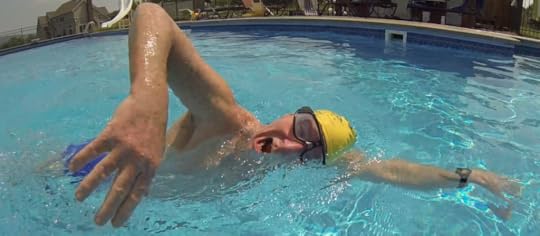
Breathing to my Right—my ‘non-natural’ but more efficient side
In the past few years–while working on our Effortless Endurance and Freestyle Mastery Self-Coaching Courses, I carefully examined my own breathing technique and found much to improve–but most of the improvement opportunities were on my left side. My non-natural breathing side had indisputably better technique. It was also noticeably more comfortable—most likely because I hadn’t had 28 years of pre-TI bad habits to unlearn on my left side.
If you’ve always breathed to one side, it will feel awkward for a time to introduce the other side. There will be a learning curve. But if you apply the same Focal Points—such as Chin follows Shoulder to Air—to breathing on your weak side, you’ll soon feel much more comfortable.
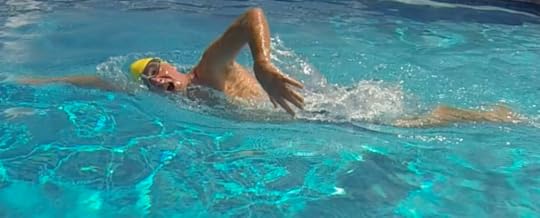
My left-side breathing is far better today—because I also breathe to the right.
Don’t be surprised if your awkward side eventually feels smoother and more comfortable than your natural side. That’s been true for me for over 10 years. And because of insights and awareness gained from my more-efficient right side, my natural left side is dramatically more efficient today than it was when I only breathed one way.
Your primary goal is to make your left and right sides identical in every regard. I guarantee that the effort to do so will make you a far more efficient swimmer.
The images above are video screen shots from Chapter 11 Seamless Breathing of the ebook for our 1.0 Effortless Endurance Freestyle Self-Coaching Course, in which Lesson 4 is devoted to learning to breathe by the same method I employed in improving my own technique.
The post What Convinced Me to Breathe Bilaterally after 28 Years? appeared first on Total Immersion.
Why I Began Breathing Bilaterally after 25 Years
In August 1972, in the first 10 minutes of the first workout I ever coached, I noticed that every swimmer on the team I’d just begun coaching had asymmetrical strokes. Those who breathed to the left torqued noticeably in that direction; right breathers did the same to the other side.
While I had no formal knowledge of stroke mechanics at the time, instinct told me that these excessive sideways motions probably hurt efficiency. When I instructed the team to breathe to the ‘wrong’ side the next day, their lack of symmetry disappeared. Before long I made it a standard requirement for the swimmers I coached to breathe bilaterally during practice.
Just above I wrote that a primary reason breathing in freestyle is such a frequent occasion for stroke errors is the difficulty of keeping the body aligned, stable and traveling forward when 8 percent of body mass repeatedly moves to the side. When we move that 8% only to one side, it’s inevitable that, over time, the body accommodates these uneven forces in various ways—none of which promote efficiency.
Though I required my swimmers to breathe bilaterally as early as the 1970s, when I got serious about improving my own efficiency in the early 1990s, I was still a unilateral breather—breathing almost exclusively to the left, as I’d done since 1964.
One day in March 1992, I decided to breathe to the right for an entire 800-meter swim. I was swimming in Los Banos del Mar, a 50-meter pool in Santa Barbara. For some time, I’d made it a habit to count my strokes. It really got my attention that my stroke count improved from 41 SPL (strokes per length) breathing to my habitual left side to 39 breathing to my unfamiliar right side. Though breathing to the right felt awkward, that measurable improvement in efficiency motivated me to continue. For several months, I breathed more to the right than to the left, which helped me adapt more quickly. I’ve been a bilateral breather ever since.
If you’ve always breathed to one side, it will feel awkward for a time. There will be a learning curve. But if you apply the series of Focal Points above to breathing on your weak side as well, you’ll soon feel much more comfortable.
Don’t be surprised if eventually your awkward side feels smoother and more comfortable than your natural side. That’s been true for me for 10 years. And because of insights and awareness gained from my more-efficient right side, my natural left side is massively more efficient today than it was when I only breathed one way.
Your primary goal is to make your left and right sides identical in every regard. I guarantee that the effort to do so will make you a far more efficient swimmer.
The post Why I Began Breathing Bilaterally after 25 Years appeared first on Total Immersion.
June 9, 2017
Can a change in technique change YOU?
To swim efficiently, you must master Balance first. I’d go so far as to call it non-negotiable. But the effect of learning Balance can be much more far-reaching. It certainly was for me.
In September 1988, I met Bill Boomer at a coaching clinic and learned that ‘the shape of the vessel matters more than the size of the engine.’ Boomer also said that Balance is the foundation of vessel-shaping–his term for streamlining your body. Though I’d been swimming for nearly 25 years, and coaching successfully for 16 years, prior to that day I’d never heard a single mention of Balance as a swimming skill—much less the most important one.
Soon after, I visited Boomer in Rochester NY to learn more about vessel-shaping and watch him coach his University of Rochester swimmers. While there, I asked Boomer to show me how to balance. He had me perform a drill while kicking lightly in a prone position with my arms back–except for the kicking, very similar to our Torpedo drill. When I aligned my head and hips, as instructed, and shifted weight forward to my chest, my hips instantly rose to the surface and my legs felt light. I was moving just as fast, but with a noticeably easier kick.
I repeated the drill several times, memorizing these new sensations, then swam a length of whole-stroke. My stroke felt stunningly different. For 25 years, my legs had felt ‘heavy.’ But after just a few minutes of practicing a simple drill, they felt light.
While the new ease I felt was exciting, the effect of the experience of swimming in balance would be much more far reaching. It changed my whole sense of what was possible—for me and all swimmers:
I’d swum only sporadically, and without real enthusiasm, for nearly 20 years since college, with no purpose other than to get exercise. Since that day, I’ve been a passionate swimmer, and my passion for swimming has only grown.
Prior to that day, the only changes I’d experienced in my swimming had been marginal and temporary. After months of hard training, I could swim longer and faster—but that effect disappeared as soon as I stopped training. The change I experienced through Balance was more dramatic than anything I’d ever known, and has become permanent. Not only do I now feel positively brilliant every time I swim but—even after missing practice for several weeks—I recapture that feeling immediately upon my return.
Experiencing such a fundamental and striking change made me realize that, though I’d swum for almost 25 years that day, I still had much to learn. And in fact, I’ve continued to learn new skills and discover new insights (kaizen!) for over 25 years since.
At age 37 (when I was introduced to Balance), I thought my best swimming was 20 years behind me. In reality, the best was yet to come! As a result of learning Balance, and many other discoveries that followed, I’ve improved continuously through my 40s, 50s, and 60s.
No More Struggle
The most limiting aspect of swimming is the sinking sensation. When your hips and legs drag below the surface, it’s impossible to feel comfort or ease, your endurance and speed are sapped, and your arms and legs are so preoccupied with fighting the sinking sensation, they’re limited in their ability to aid in streamlining or propulsion.
Poor balance is the reason only 30 percent of American adults can swim 25 meters. Besides the fact that ‘survival swimming’ is exhausting, the sinking sensation makes it impossible to enjoy swimming—or to anticipate eventual success. That constant sense of lacking control also blocks the calm focus needed to learn new skills.
However, if you can solve such profound problems, you should also gain a sense of confidence in dealing with future challenges along the way.
When you eliminate the sinking sensation and feel a sense of control over your body you immediately feel much more ‘at home’ in the water. You also achieve the foundation for every skill that follows.
Balanced Body, Focused Mind
The effects of balance practice on your mind and psyche are as profound as those on your body. Total Immersion’s balance learning sequence—in combination with structured use of balance-oriented Focal Points—has been designed to prepare you cognitively as well as physically for a successful learning experience.
A combination of targeted mental focus with unhurried movements and moderate heart and respiration rate puts the brain into a state of relaxed alertness known as the Alpha brainwave pattern (8 to 12 cycles per second.) Cognitive scientists call this the Superlearning zone.
Learning, practicing–and feeling–Balance creates a ‘virtuous loop.’ You feel good physically and mentally while Swimming in Balance, That motivates you to do it more–which results in improvement to those positive feelings. So you spend even more time Swimming in Balance.
May your laps be as happy–and balanced–as mine.
The post Can a change in technique change YOU? appeared first on Total Immersion.
June 2, 2017
Take a ‘Sabbatical': Transform your swimming or Pursue Mastery
The saxophonist Sonny Rollins, now 86, has not performed in public in four years because of poor health. However, he remains the jazz world’s most respected living performer, recognized for his impressive practice habits– eight or more hours a day, well into middle age–and the sabbaticals he took to improve his technique.
I love reading examples of eminences from different fields, who exemplify the principles of Kaizen, Mastery, and Deliberate Practice. I recently read an account of Rollins’s commitment to those ideals that thrilled and delighted me.
Between 1953 and 1959, Rollins released 21 full-length albums, an output that now seems otherworldly. As the writer put it, “music rushed out of Rollins like an overfed river.” And it wasn’t only the prodigious quantity, the quality was also unsurpassed. At age 28, he was considered the greatest tenor saxophonist of the day.
Yet in 1959, Rollins stopped performing and recording. For the next two-and-a half years, from the summer of 1959 to the end of 1961, he played nearly every day atop the Williamsburg Bridge, which crosses the East River between Brooklyn and lower Manhattan. (I swam under this bridge in 2002 and 2006 during my two Manhattan Island Marathon Swims.) He chose this location—a few blocks from his apartment—so he could play all day long without disturbing his neighbors, and for the quality of the sound in the open air.
Among jazz musicians, taking a sabbatical to obsessively hone one’s craft is sufficiently common that it’s been given a name–woodshedding. Yet Rollins was already at the top when he took his sabbatical. He used it to break new ground and move jazz in new directions.
Reading an account of this reminded me of a 10-year sabbatical I took from Masters meets and conventional training to refine a new way of swimming freestyle, to which I’d been introduced by, the innovative coach Bill Boomer. Actually, that makes my initial intent sound far too grandiose. At the start, I was focused mainly on enjoying swimming more. The evolution of a new form happened bit by bit, with many unexpected revelations along the way.
Boomer’s innovation was captured in one pithy sentence: “In swimming, the shape of the vessel matters more than the size of the engine.” While his concept was clear, his description of specific techniques for minimizing drag was sparse. In 1993, there was no guidebook for ‘fishlike’ freestyle. TI workshops became a large-scale laboratory for developing and standardizing techniques and a learning method. But, outside the workshops, I needed to develop the skills and drills we’d teach in them.
Prior to this sabbatical, for nearly three decades, like a hamster on a wheel, I had reflexively swum interval repeats each time I got in the pool. Breaking that habit provided a sense of unprecedented freedom to practice for pleasure rather than conditioning. I didn’t even feel constrained to use conventional strokes. I experimented with new ways to move through the water and devised several drills that never made it into our curriculum.
I was in pursuit of two things:
Shaping my body for the lowest drag profile and moving through the water without disturbing it;
To feel better in the water.
A Canadian coach named Howard Firby had coined a term to describe an extreme-low-drag version of butterfly or breaststroke. He called it “slither-slink.” This pretty closely described the movements I was performing and sensations I was experiencing. I developed many ways to slither-slink through the water—enjoying an unprecedented sense of moving through water like an arrow through air.
Yoga-inflected Swimming
Just as I began my intensive period of remaking my swimming and developing the TI techniques, I also began yoga practice, in a style called Iyengar, that emphasizes detail, precision and alignment in the performance of postures or asanas. We’d regularly hold a posture for six or more breaths, making small adjustments. I was struck by how much critical detail could be present in even the simplest poses, such as mountain pose—standing with arms at sides.
After several years of Iyengar, I did my first ‘flow’ or vinyasa class–changing positions on each breath. I was grateful for having done years of Iyengar, to familiarize with each of the asanas I was now moving through so quickly.
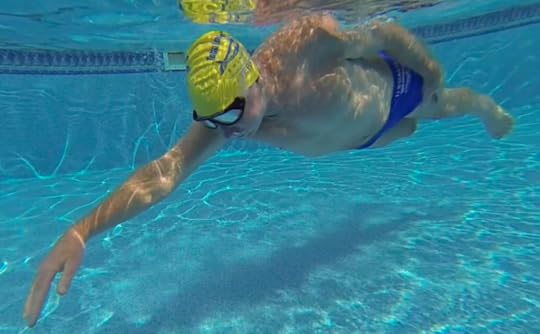
Freestyle Skate
This revealed to me that a freestyle stroke is like a much-more-hurried vinyasa, moving through a series of critical positions in a single breath. That led me to identify the most critical position in each stroke—the moment where drag is lowest—and pause the action to allow small adjustments. This led to development of our Skate drills which, ever since, have been our most important drills for freestyle and backstroke.
A striking thing about this period of deep practice is that, for nearly 10 years, my personal focus remained on vessel-shaping or lowering my drag profile. I gave almost no attention to the pull and kick. Today we recommend that new TI students allow three to six months’ attention to vessel-shaping before turning to propulsion skills.
Yet during this time I never sensed a slackening of my learning curve. This is possibly because vessel-shaping was a new skill and there remained, well, everything to be discovered about it. Since I did relatively little timed swimming during this period, two other measures came to the fore—stroke count and degree of pleasure I experienced while swimming. My average stroke count per 25 yards—17 in the early ‘90s—dropped to 12 to 13 in the early ‘00s. (Now it’s back up to 15 to 16 strokes—a story for another day.) And the sheer pleasure of moving through the water increased continuously.
If you took a sabbatical from your habitual swimming routine, how would you use it and what might change as a result?
The post Take a ‘Sabbatical': Transform your swimming or Pursue Mastery appeared first on Total Immersion.
May 26, 2017
Message from Terry, and Memorial Day Sale Announcement!
Here in New York’s Hudson Valley, and many parts of the world, Memorial Day marks the start of summer. And for many of us, summer is synonymous with swimming in the great outdoors.
Whatever your reasons for swimming—recreation, fitness, endurance, or speed–your chances of success and satisfaction will increase enormously if you approach swimming as a skill to be improved—rather than test of endurance. Fitness ‘happens’ while you work on existing skills and learn new ones.
Total Immersion techniques have been refined over nearly 30 years with countless thousands of students—most of whom had little skill or experience.
We follow the same sequence of foundational skills with every student and every form of swimming. When you learn these skills you’ll be able to:
Swim farther and faster using less energy
Enjoy every stroke and improve continuously
Swim free of injury or pain
Our programs are designed to allow you to take charge of your own improvement. More than just technique videos – our self-coaching courses are the closest thing to personal instruction from a TI Coach.
To kick off this glorious season we’re offering a 40% discount on all Total Immersion videos and Self-Coaching Courses, this weekend only!
***** Use coupon code SUMMER2017 at checkout to save 40% *****
The post Message from Terry, and Memorial Day Sale Announcement! appeared first on Total Immersion.
May 18, 2017
Should you quantify performance?
In response to my post about appearing on the Mile High Endurance podcast, Marcus posted this comment: I enjoyed this podcast. It was very informative. It made me think about my reluctance to quantify my performance either with gauging how fast it takes me to swim 25 meters to how many strokes it takes me to swim the same length. My fear is that my subjective assessment might not match up to what the quantified results say. I think that my TI practice is still in its budding stage and I fear I might become discouraged if I quantify it. Still, I do see the merits of quantifying.
Marcus, I totally understand that reluctance to measure performance, lest it fall short of the expectations you may have at the moment. Dr Carol Dweck of Stanford wrote about two groups of young students. One group shied away from taking difficult tests, fearful that test results might reveal them to be less smart than others thought they were. A second group looked forward to difficult tests because their self-image was based more on their willingness to tackle difficult challenges, than on an external perception that they were smart or average. The former group was said to possess a Fixed Mindset; the latter a Growth Mindset.
Your reluctance to time yourself for 25m does not mark you as having a Fixed mindset. Indeed the result of your time trial could be known only to you. And I strongly support TI swimmers whose values are strongest on swimming that feels and looks great, without needing to quantify that with a time.
However, I also encourage such swimmers to consider getting a mathematical measure. Not just time, but time plus stroke count, or time plus tempo. Time plus another measure is far more meaningful. Since you do sound inclined to overcome this reluctance, I’ll note that the way to defuse ‘performance anxiety’ is to think of the measure you use as simply a piece of information. It’s not inherently good or bad. It does however give you a starting point for measuring your improvement in a mathematically specific way.
Coincidentally, when I read your comment I’d just finished writing something about another TI swimmer who did choose to time himself for 25m. I used his example as the opening of a guest chapter I wrote about aging healthfully through movement. Here it is. I hope it encourages you to overcome your reluctance.
* * *
How many individuals do you know who—nearing 70 years of age—are striving to achieve personal bests in a sport measured by time and distance? And how many people–in any age group–do you know who are pursuing improvement by regularly and rigorously analyzing what they do, seeking weaknesses, and trying to convert them into strengths?
Such behaviors are quite rare in the world at large—even among those in their 20s or 30s, let alone four decades older. However, they are surprisingly common, at all ages, in the community of Total Immersion swimmers.
The day I began writing this chapter, I received an email from Wayne Britton, 68, of Pembrokeshire, England. Wayne described himself as a ‘recreational’ swimmer, but his message made it evident that a more accurate description was Kaizen swimmer–one devoted to thoughtful self-examined, pursuit of continuous improvement.
Wayne learned front crawl from a traditional (non-TI) coach shortly before turning 60. Five years later, seeking more refined technique, he attended a Total Immersion Effortless Endurance workshop. At the conclusion of the workshop, Coach Tracey Baumann counted his strokes and timed him for 25 meters. This gave Wayne a set of ‘baseline’ metrics—25 meters in 32 strokes and 46 seconds—data from which he could track improvement.
Over the next year, Wayne improved to 42 seconds and 26 strokes. Seeking to boost his progress, Wayne attended a TI Smart Speed workshop. While there, coaches Keith Lewis and Mike Weedon persuaded him to focus on developing a more streamlined stroke—and to let gains in speed be products of that, rather than being overt goals. Since then he’s improved his 25m stroke count to an average of 20 SPL (strokes per length) while swimming 50m repeats in 78 seconds.
At the present, Wayne’s focus is on feeling more consistency in “moving through the water with a relaxed, graceful, no-splash stroke.” Wayne has also begun working with a Tempo Trainer, which allows him to increase tempo in precise increments of .01 (one-hundredth) second at a time.
May your laps be as happy and purposeful as mine.
The post Should you quantify performance? appeared first on Total Immersion.
May 12, 2017
Mind-Body Training: Self-Sensing and Technique Focal Points
Elite athletes appear different—physically–from the rest of us; they seem to have been ‘born to greatness.’ For instance, the world’s best freestylers are much taller than average, with supple joints and broad shoulders/narrow hips. Their bodies seem designed to maximize power, minimize drag, and produce naturally superior stroke length.
But elites also share a less obvious advantage over average athletes: studies have shown they possess far greater kinesthetic, or sensory, awareness. And while elites in all sports have superior self-sensing ability, it rises to its highest level in swimming. This is because swimmers are immersed in a sensory-rich environment, in which every square millimeter of skin receives feedback from the water. We literally swim in a ‘sea of information’ which offers potentially invaluable guidance on how to increase efficiency. Coaches call this “feel for the water” and speak of it as a magical or even mystical quality: A tiny number of athletes—like Michael Phelps and Katie Ledecky–just have it from birth and others . . . well, those unfortunates just lack it.
However, in teaching late-starting adults for over 25 years, I’ve seen countless times that feel for the water is learnable. You cultivate it by doing something that comes naturally to very few swimmers—and is not an explicit part of any traditional training program. I’m referring to training in which Self-Sensing is a formal, systematic, and indeed foundational element, given equal or greater importance as aspects like distance, time, and effort.
You cultivate it by doing something that comes naturally to very few swimmers: placing primary emphasis on the formal and systematic training of one’s sensory faculties. This approach has thousands of years of history in movement or martial arts like T’ai Chi and Qi Gong, but is practically unknown in swimming.
The development of a high level of self-sensing ability is the first element in the Mind-Body training approach taught by Total Immersion. Its most immediate benefit is that—unlike physical characteristics or fitness—average swimmers can equal or surpass elites in feel for the water by including self-sensing elements as a core part of their training program. A more holistic benefit is that it produces many of the salutary effects of mindfulness training (which is based on self-sensing of the breath, posture, mind-focus, etc.) and transforms tedious and repetitive training into an engaging and enjoyable activity.
3 Steps to Greater Awareness
Introduce Self-Sensing elements and tasks to your training via a 3-step process:
Pay attention. Create an organized and prioritized way to scrutinize specific aspects of your stroke. While swimming laps or participating in group training, it’s likely everyone around you will be focused mainly on getting to the other end of the pool, “getting through” the set . . . or musing idly on what they’ll do when the workout ends. In contrast, you will choose a specific focal point—e.g. head-spine alignment, how the water resists various body surfaces, or the noise produced by your stroke—then focus on it intensely and At first, this will be quite challenging. But, like maintaining focus in meditation, your ability to concentrate improves with practice. You’ll also find that it makes any lap, practice—or race–more enjoyable.
Notice and compare. When ‘targeted’ attention becomes a habit, you’ll begin to notice subtle sensations you’ve always overlooked. This feedback can be invaluable to improving elements of stroke efficiency like drag and stroke-integration. Once you create formal feedback loops, begin to assess what this feedback means and how to respond: Do you swim faster with more ease, or fewer strokes? Does one focus make your stroke feel better overall than another?
Make informed choices. Use this new information to make more effective choices. This transforms formerly generic or “one-size-fits-all” training into a personalized problem-solving exercise. This adds a sense of purpose to the engagement and enjoyment produced by the mindfulness part of Self-Sensing training.
Three Ways to Organize Self-Sensing Training
Like any form of training, you’ll get the best results from this training by doing it in a systematic way. Here are three ways of organizing. With practice, you can employ all three in a single set, but I suggest you start more simply by choosing one.
By Skill: In the TI hierarchy of technique skills, Balance ranks highest, Streamlining skills come second, Integrated Propulsion skills come third. If you’ve had little formal technique instruction, or feel that you work too hard for too little result, the biggest payoff will come from the first two skills.
By Type: There are three types of focus—internal, external, and visualization. With internal focus, you send a message from brain to body part; e.g. relax all forearm muscles during recovery. In external focus, you pay attention to sensory input from your environment—for instance, the sound of an arm entering the water. In a visualization, you add a familiar element to the overall picture—for instance, an imaginary towline attached to the top of your head. Combining internal and external focus is especially effective in increasing self-perception.
By Body Part: Our favorite way is a front-to-rear body scan and inventory. First check the position, orientation, or direction of head or extended hand and arm, then torso, then legs.
Improve Sensory Awareness with this Set
Warm up, then do a short ‘benchmark’ swim—from 50 to 200y/m at a moderate or ‘cruise’ pace. Count strokes, take time and give a ‘perceived effort’ rating—from 1 for effortless to 5 for exhausting.
Swim 4 to 8 x Focal Point/Self-Sensing 25s for each skill category described below. Your goal is to: (i) focus intently on a specific sensation in your stroke; and (ii) incrementally strengthen that sensation during the set. (I frequently close my eyes involuntarily while doing this, to heighten my sensitivity to sensory input.) After each 25, assess the sensation, and your consistency of focus. Use your interval between 25s as much for a mental reset, as for physical rest. To improve your outcome, continue visualizing your stroke between repeats—to deepen the mental imprint of what you’re striving to feel.
Choose your favorite sensation—or try to blend two or more. Repeat the benchmark swim. Can you swim as fast with fewer strokes and/or less effort? Choose the most promising sensation and work at it until it becomes stronger and more consistent. Enjoy the sense of increased efficiency, engagement and purpose this brings.
If you need help with focal points for the set above, choose from this list:
Balance: Feel that your head is weightless–fully supported by a ‘cushion’ of water. Also, notice if: (1) head and spine feel more aligned; and (2) neck and upper back feel more relaxed.
Streamline: Focus on how you enter and extend your hand. Enter as quietly as possible, then reach a little farther than you do normally. Notice if: (1) your hand, arm, and shoulder enter with less water disturbance—especially just after each breath; and (2) you feel a bit ‘taller’ and sleeker in the water.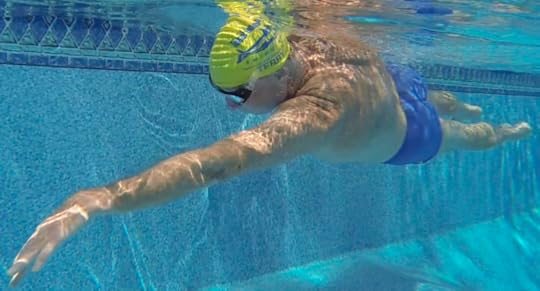
Integrated Propulsion: Pay attention to the perceived speed of your hand moving back. Compare with the speed of your body moving forward. If your hand is moving noticeably faster than your body, slow or ease your stroke until the two match. Notice if your stroke feels smoother and more integrated when you sense a speed match.
The workbook for our 1.0 Effortless Endurance Freestyle Self Coaching Course is chock full of guidance on how to hone your self-sensing abilities–and pictures like the above to plant a powerful visual image to help guide you.
The post Mind-Body Training: Self-Sensing and Technique Focal Points appeared first on Total Immersion.
May 5, 2017
A Podcast on Stroke Efficiency, Stroke Count, Swim Gears, Self-Coaching Courses and Much More.
I returned to the Mile High Endurance podcast for the third time–the most times I’ve ever guested on a podcast. MHE host Rich Soares has converted to an avid TI practitioner since my first guest appearance and can consequently bring valuable insights to our discussions.
Rich and I begin our discussion right around the 22:00 mark. Early on I talk about my experience at Camp Eton–and how I was struck by the hard-to-ignore idea that even today I could still aspire to doing an English Channel solo.
At 34:30 we begin talking about Stroke Length, the choices you might make with respect to SPL in training or pool racing and the importance of training yourself for the capability to be highly skilled at ‘flexible’ SL.
Between 37 and 40 minutes I talk about why it’s so important to attain mastery of Gears in all three popular endurance disciplines–running, cycling, and swimming.
Between 40 and 43 minutes I talk about how and why my stroke count range has changed over the past 50 years and is still changing today, due to the effects of illness and treatment.
Then Rich used his evolving insights and discoveries for working with SPL and Tempo to lead us into discussion of those tools for training.
Between 48 and 53 minutes we talk about how to shape your vessel to transform yourself into a human barracuda and how to employ ‘active’ streamlining as you stroke in freestyle.
Between 53 and 60 minutes we talk about how the 2.0 Freestyle Mastery Self Coaching Course naturally follows and logically completes the skills taught in the 1.0 Effortless Endurance Freestyle Self-Coaching Course.
Also Rich gives a masterful account of why he finds it beneficial to use a Finis Swimmer’s Snorkel while imprinting all the small distinctions of the barracuda-shaped Torpedo position and his realization of the value of a long ,patient warmup devoted to taking a fine-grained inventory of every aspect of his ‘active’ streamlining.
Our conversation continues with many more worthwhile topics and nuggets through the 1 hour 18 minute mark followed by a discussion between Rich and his co-host Bill Plock (who didn’t join in on our conversation this time).
Please set aside some time this weekend to give it a listen–perhaps breaking it into 2 to 3 pieces. I promise you’ll find it enjoyable and edifying.
http://www.totalimmersion.net/blog/wp-content/uploads/2017/05/Episode_071_2017_04_30_Terry_Laughlin_of_Total_Immersion_Swimming.mp3
The post A Podcast on Stroke Efficiency, Stroke Count, Swim Gears, Self-Coaching Courses and Much More. appeared first on Total Immersion.
May 3, 2017
Guest Post: Shane Eversfield (aka Zenman)
Introduction: In this guest post and video, Shane Eversfield describes lessons he learned–from his first Ironman–about the importance of focusing on process, one stroke or stride at a time, not the far-away finish line. Three years later I learned the same lesson while swimming the 28.7-mile Manhattan Island Marathon Swim. Fortunately it felt completely natural to do so, as I’d been doing improvement-oriented (Kaizen) swimming for over 10 years. A focus on improving your swimming leads naturally to giving undivided attention to every stroke. So during that swim, my first ultra-marathon, I took one purposeful stroke, nearly 27,000 times.
May your strokes be as happy and purposeful as mine, Terry Laughlin
In 1999, Hawaii Ironman was to be my third triathlon ever. Well… I almost killed myself as I trained for that event. As terrifying as that experience was, it offered me a valuable lesson that has helped me to go far beyond iron:
Ironman is not 140.6 miles. It is one mile 140.6 times. There is a profound difference.
The same adage is true for any distance – especially when that distance is the longest you have ever attempted. In the environment of competitive endurance sports, we tend to get very goal- focused. Sure, it’s healthy to set attainable goals and strive to reach those goals. However, those very same goals can get us into a lot of trouble – even if they are attainable.
In this six-minute video-blog, I offer you some insights on how to temper your goal drive and to balance it with the other key element of training and racing. These insights are just a few of many I offer in my new book – the first in a series of five.
I’ve just published a new e-book, “An Introduction to Kaizen-durance, Your Aerobic Path to Mastery” – available through the Total Immersion online store.
I also invite you to visit the Kaizen-durance website.
- Shane “Zenman” Eversfield, Total Immersion Master Coach, Founder and Head Coach of Kaizen-durance
The post Guest Post: Shane Eversfield (aka Zenman) appeared first on Total Immersion.
April 28, 2017
Camp Eton and Lemons-into-Lemonade
Two weeks ago, I made a quick visit to the UK to be a guest coach at an event called Camp Eton. English Channel luminary Nick Adams hosts this camp for English Channel aspirants annually at Eton, the historic boys school (founded by King John V in 1440) near Windsor Castle at which Nick teaches math and coaches the swimming team. Nick and I had talked for years about my participating as a guest coach. Back in February I’d decided—if I’m ever going to attend Camp Eton, it has to be this year.
Nick has swum the Channel dozens of times, dating back to his mid-teens, including several 2-way crossings and one unsuccessful 3-way attempt. Swimming the Channel has become almost routine for Nick, as he does it annually. Most years he also guides a group of Eton boys in a relay crossing.
During the weekend, there are morning and afternoon pool sessions each day, wrapped around seminars on essential topics such as:
• Feeding and Hydration
• Pilots, Tides and Courses (the best route across can change on an hourly basis, depending on shipping traffic, wind, and how water is moving through the channel)
• Hypothermia and all things medical (expertly delivered by Sakura, Nick’s wife, who is both a Channel vet and an MD); and
• The Care and Feeding of one’s Support Crew.
The pool sessions were devoted mainly to long sets of relatively short interval repeats. This was a valuable experience for camp attendees because while most have a lot of experience with long training swims in open water, few have experience with organized repeat training in the pool.
I joined the campers in the water for a portion of both morning practices, swimming 3000 meters on Saturday and 5700 meters on Sunday. The group did 100 x 100 (something I’d done in a 25y pool on March 26 and wrote about in the post A Birthday Swim to Remember) on Sunday morning. They began at 6am sharp. I opted to sleep in, because my body clock still thought that was 1am. But I arrived in time to swim 57 x 100m on an interval of 2:10.
I was hugely pleased with this repeat series because
• Unlike nearly every other practice I did during April (see below), I felt really good.
• I paced it exceptionally well, starting my 100m repeats at 1:58 (going super-slow to ease into the groove of a long set) and swimming my final 100 at 1:43. I’m quite sure no one else in the pool managed to swim their final 100 15 seconds faster than their first.
• I felt relaxed and highly efficient throughout—averaging 16-to-17 SPL for 25m until the very end when I intentionally increased to 17-to-18 SPL.
• I shared a lane with a couple of participants who’d swum the Channel in the last year or two, and consistently outswam them by a fair bit, while swimming much more easily. This got me started thinking “Could I still swim the Channel, despite my health challenges?”
A pool full of Channel swimmers—transformed in 2 Hours
My favorite part of the weekend was when TI Master Coach Tracey Baumann and I got to teach TI techniques. When we walked on deck at 7am Saturday, I had to metaphorically avert my eyes, so unpleasing was the overall quality of movement among nearly all of the 27 swimmers packed into six lanes. In fact, I immediately noticed the lone swimmer in the pool whose stroke was graceful.
When I pointed him out to Tracey, she replied “That’s my swimmer, Kevin Mullarkey.” Kevin’s had lessons in her Swim Studio in Wraysbury (10 min drive from Eton) England and swims regularly in her Thursday evening TI group practice.
Tracey and I taught TI for a total of two hours over the weekend—30 minutes at the end of the afternoon pool session on Saturday and another 90 minutes on Sunday afternoon. We also recorded surface and underwater video of each swimmer for analysis in the classroom.
On Saturday afternoon, we worked on achieving a weightless, aligned head and the Mail Slot entry. They looked considerably better already. In the change room afterward, a couple swimmers commented, “I wish we’d done that at the beginning of the day.”
On Sunday afternoon, we reviewed Saturday’s skills for 30 minutes, then worked on the recovery, with Rag Doll and Draw a Line focal points, and finally worked on sneaky and seamless breathing. Though we were only two coaches working with a pool full of 27 swimmers, did no drills and no hands-on coaching, the profound transformation of movement quality all over the pool was thrilling. We both feel as if the significantly improved efficiency of these swimmers will give them all a much better chance of injury-free preparation for their Channel swim and a greatly enhanced chance of making it to France.
My April chronicle: Embracing the challenge—Making lemonade from lemons.
Swimming-wise, April has been a challenging month for me. After my fantastic experience swimming 100 x 100 on March 26—and feeling full of energy afterward—about a week later I began to fatigue unaccountably while swimming.
The symptoms have remained consistent throughout the month. No matter how easily I swam I felt breathless after 100 yards. I also felt a burning sensation in my chest and arm muscles, that I’m familiar with as signaling the presence of lactic acid in my muscles. Both sensations are symptomatic of being in an anaerobic state—though I was swimming about as easily as I could, and mostly for durations shorter than 2 minutes.
I swam a 1000-yard race on April 7 and—though I’d rested (no swimming) for three days prior to the meet, and swam very conservatively throughout–I already felt breathless by 500 yards. My 1000-yard time of 16:19 was a slower pace per 100 than the 1650 (65% longer) I’d swum just three weeks earlier, during which I felt fantastic and completely pain-free throughout. How could I have lost so much in just three weeks, I asked myself?
It got no better from there. Each of the next three weeks, I recorded a new ‘lifetime slowest’ 100 yards (a swim paced to complete multiple repeats, not an all-out effort) seemingly every week. However, I responded to each in the same way.
1. I embraced the principle stated in the title of Tibetan Buddhist teacher Pema Chodron’s book Start Where You Are. I accepted that I ‘owned’ the time I’d just done.
2. I then began to work on finding still easier ways to swim that time, by streamlining better, slipping my arm in with less water disturbance, applying pressure in the catch with more patience and sensitivity.
3. Sure enough, not only was it easier to swim that time, but it began to improve.
Last night, at Masters, my first 100 of the evening was 1:53. Two years ago I’d have found it impossible to swim 100 yards that slowly. However my final 100 of the practice, a bit over an hour later was 1:35—a time I’d seen only once previously this month.
This month I made lemonade from lemons among the English Channel aspirants at Camp Eton, then with my own swimming.
The efforts I applied last night to bring my 100y time down from 1:53 to 1:35 were directly inspired by what we teach in TI 1.0 Effortless Endurance Freestyle Self-Coaching Course. 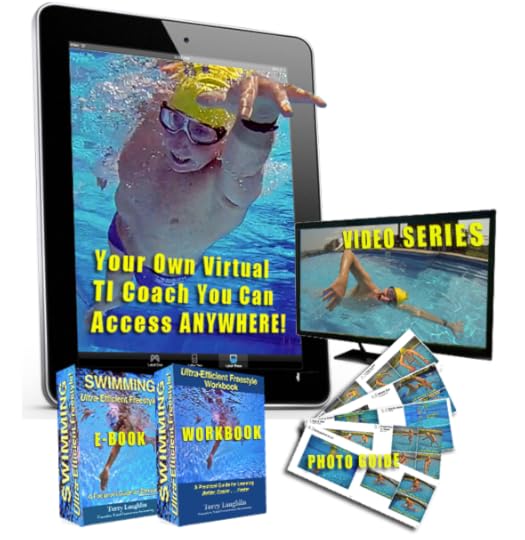
The post Camp Eton and Lemons-into-Lemonade appeared first on Total Immersion.
Terry Laughlin's Blog
- Terry Laughlin's profile
- 17 followers


